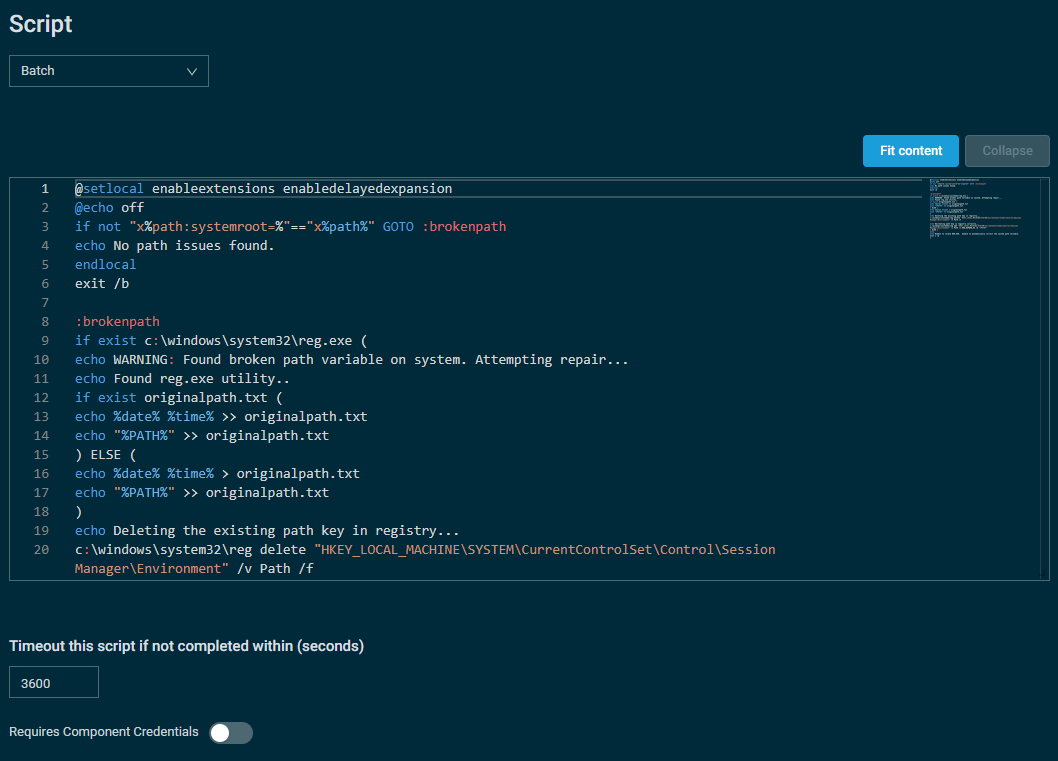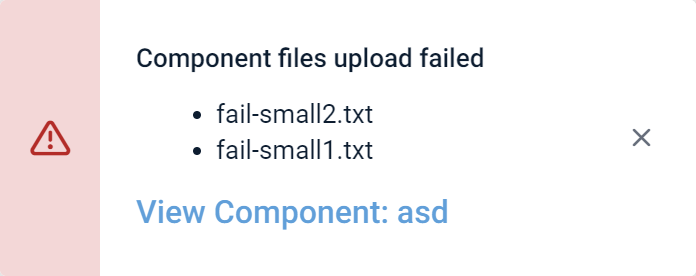Creating a component
PERMISSIONS Refer to Components > Components in Permissions.
NAVIGATION Automation > Components > Create Component
About
In addition to downloading a component from the ComStore, you can create components yourself and share them with other users. A typical component contains a script written in one of several available scripting languages. It may also contain a program to install or an executable to run.
The Datto RMM Support team covers the following:
- Troubleshoot jobs associated to scripts/components.
- Investigate if a script runs successfully outside of Datto RMM but does not run successfully in Datto RMM.
Datto RMM Support does not cover custom script/component creation. Partners are advised to contact their account manager for a Professional Services engagement if they require assistance with script/component creation.
For more information, refer to Getting support for components.
Creating a component
To create a component, follow the navigation path described in Security and navigation.
Enter a name for the component.
Click the plus icon to choose an icon to represent the component (48 pixels wide by 48 pixels high, PNG/JPG/GIF file format). PNG and JPG icons larger than this will be resized, while GIF icons larger than this will not be resized. If no icon is added, a default icon will be displayed.
Enter a description for the component.
Select one of the following component levels from the drop-down list:
- Basic (1)
- Low (2)
- Medium (3)
- High (4)
- Super (5)
The component level you select will determine which users can access the component. A user will only be able to see components that are available to them based on their component level. Refer to Component Level in Users.
EXAMPLE For example, a user whose component level is set to Super (5) will be able to view all components in the Component Library; while a user whose component level is set to Medium (3) will only be able to view components with a component level of Medium (3), Low (2), or Basic (1). When editing a component's component level, a user can only select a component level that is available to them based on their component level in their user settings.
Select Applications (default), Monitors, or Scripts for the component category.
NOTE If Monitor is selected, this cannot be changed later.
Configure the following settings:
- Select Batch, PowerShell, Shell (Unix, macOS), or VBScript for the type of script this component will run. In the text field below, enter the script. You can enter the script contents line by line, or you can copy and paste an entire script into the field. For more information about scripting, refer to Scripting and Scripting Ninite using Datto RMM. Select Fit Content to view the entire script on the page or Collapse to fit the script into a smaller, scrollable window to save space.
- Timeout this script if not completed within (seconds): Allows you to set the maximum amount of time, in seconds, after which the script will time out.
- Requires Component Credentials: Only available for the categories Applications and Scripts. If installing this component requires a username and password that is unique for each site, enabling this setting will allow Datto RMM to use cached component credentials. To learn how to cache component credentials, refer to Component credentials.
Select one of the following options:
- All Sites: the component can be deployed to devices belonging to any site.
- Selected Sites: select the sites to which this component can be deployed. Security levels without access to one or more of these sites will not be able to view this component. Select Add Site to open a pane on the right and then click Add or Remove to add or remove individual sites to or from the list.

You can also remove sites from the list by clicking the delete icon to remove a specific site or Remove all to remove all sites.
to remove a specific site or Remove all to remove all sites.
NOTE In order to select this option, your security level must allow you access to all sites in the account. Refer to Device visibility.
IMPORTANT Limiting a component to selected sites only works for Quick Jobs and User Tasks.
Select Add Variable to add a variable for this component. For more information about variables, refer to Input variables.
NOTE While you can define output variables in the legacy UI, they are not displayed or supported in the New UI. If a monitor component containing output variables is edited in the New UI, the output variables will be deleted from the component, which will not affect functionality. A component monitor that meets StdOut requirements will return data without requiring additional configuration via output variables.
Select Add File to add files for this component. Only available for the categories Applications and Scripts. Click a file name to download that file to your device or the delete icon ![]() to remove a file. For information on how to use files in a component, refer to Attached files.
to remove a file. For information on how to use files in a component, refer to Attached files.
NOTE You can have more than one file in the component, but each file must not be larger than 3 GB. In addition, you should not exceed a component size of 5 GB total.
NOTE The contents of uploaded files are not verified by Datto RMM.
Post conditions examine the output (StdOut or StdErr) from a script and display the entered warning text if a specific text string is either found or not found in the output.
NOTE If one or more post conditions are met when running the component, then the job will finish with the job status of Warning.
Select Add Post-Condition to add post conditions for this component script. Only available for the categories Applications and Scripts. For more information, refer to Post-Conditions.
Click Create Component to save the component or click Cancel to discard the changes.
NOTE You will be able to save the component only if you have entered a name for it.
A pop-up notification will indicate if the component was saved successfully.
NOTE If the component fails to save, ensure that the body of the component script does not contain any icons or emojis, as these are not supported.
If you added files to the component, another pop-up notification will indicate if the file upload(s) failed or succeeded. You are notified of file upload failures as follows:
- If certain files cannot be saved and Datto RMM can identify those files, the component will be saved without those files. In the pop-up notification, you can see the failed file names and click the hyperlink to view and edit the component.

- If certain files cannot be saved and Datto RMM cannot identify those files, the component will be saved without any files. In the pop-up notification, you can click the hyperlink to view and edit the component.

NOTE If you want to test the component script outside of Datto RMM, it is recommended that you run the script as LocalSystem to mimic the way the component will run when pushed via Datto RMM. Refer to How do I log in as a LocalSystem user to test scripts?
Viewing and managing components
To view or edit a component, navigate to the Component Library and click the component's name, or click Edit or View next to the component.
When viewing a component, the following additional information is displayed at the top of the page:

| Field | Description |
|---|---|
| Delete | Allows you to delete the component. Refer to Delete. |
| Copy | Allows you to make a copy of the component. Refer to Copying a component. |
| Export | Only available for components you have created or copied. Allows you to export the component. Refer to Exporting a component. |
| Updated Needed | Only available for components downloaded from the ComStore. Allows you to update the component if an update is available. Refer to Update Needed. |
| UID | Displays the unique identifier of the component. |
| Version | Only available for components downloaded from the ComStore. Displays the version number of the component. |
| Created By | Only available for components you have created or copied. Displays the name of the user that created the component. |
| Date Created | Displays when the component was created. |
| Last Edited By | Displays the name of the user that last edited the component. |
| Last Edited | Displays when the component was last edited. |
To update the details of a component, refer to Creating a component. Click Save Component when finished.
NOTE You can edit all details of components you have created or copied; however, components downloaded from the ComStore only allow for the component level to be updated. When editing a component's component level, a user can only select a component level that is available to them based on their component level in their user settings. Refer to Component Level in Users.



